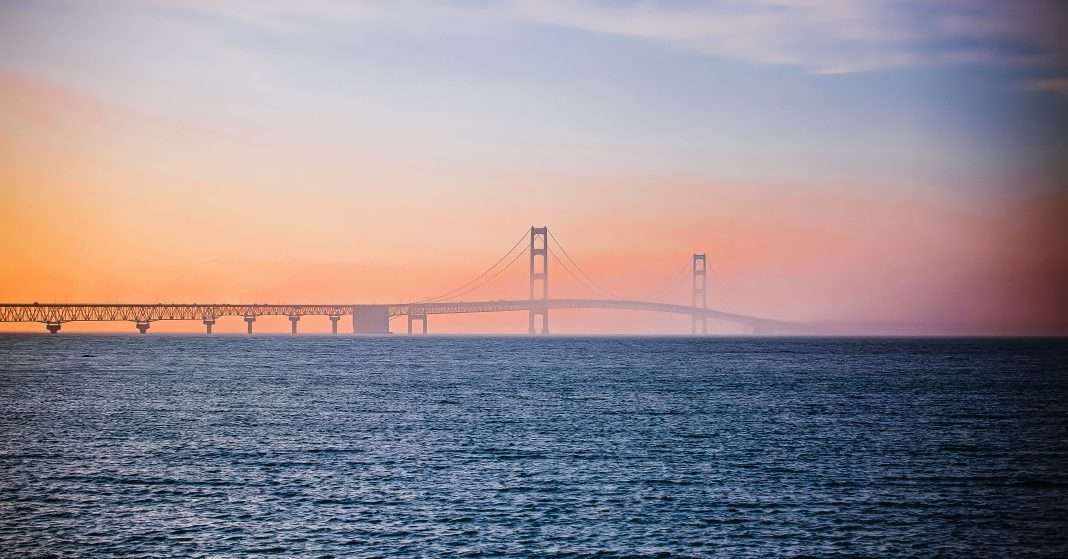A 71-year-old pipeline that pumps ~23 million gallons of crude oil and natural gas liquids per day lies beneath the largest source of freshwater on Earth. We don’t need to fix it. We need to shut down Line 5.
Line 5 isn’t just a pipeline. It’s a loaded gun. And most people who call the Great Lakes Basin Region home don’t realize the risk, or they would be screaming “shut down Line 5!”
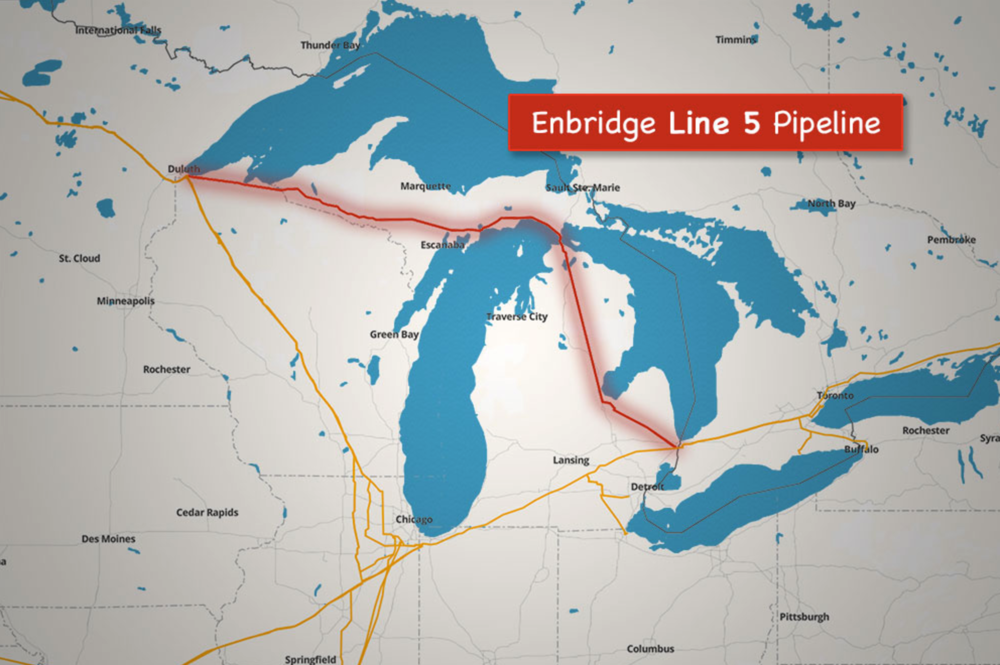
Line 5 is a 645 mile oil pipeline running from Superior, Wisconsin to Sarnia, Canada. It crosses over 400 ecologically sensitive wetlands and waterways, including a portion that lies beneath the most ecologically important freshwater system on the planet—the Great Lakes at the Straits of Mackinac. It’s where Lake Michigan and Lake Huron merge. And it’s aging badly. One anchor strike. One stress fracture. One ignored warning sign—and the Great Lakes as we know them are gone.
A 2016 study by the University of Michigan modeled 840 potential spill scenarios and concluded that a rupture could impact over 700 miles of shoreline within a matter of days.
That’s not just an environmental catastrophe. That’s public health collapse. That’s mass displacement. That’s the end of life as we know it in the Great Lakes Basin.
The History They’d Rather You Forget
Line 5 was built in 1953—during the Eisenhower era, before the EPA even existed. It was never designed to last into the 21st century. Its projected lifespan was 50 years. We’re now in year 71.
Over the past decade, multiple inspections have revealed severe and worsening risks:
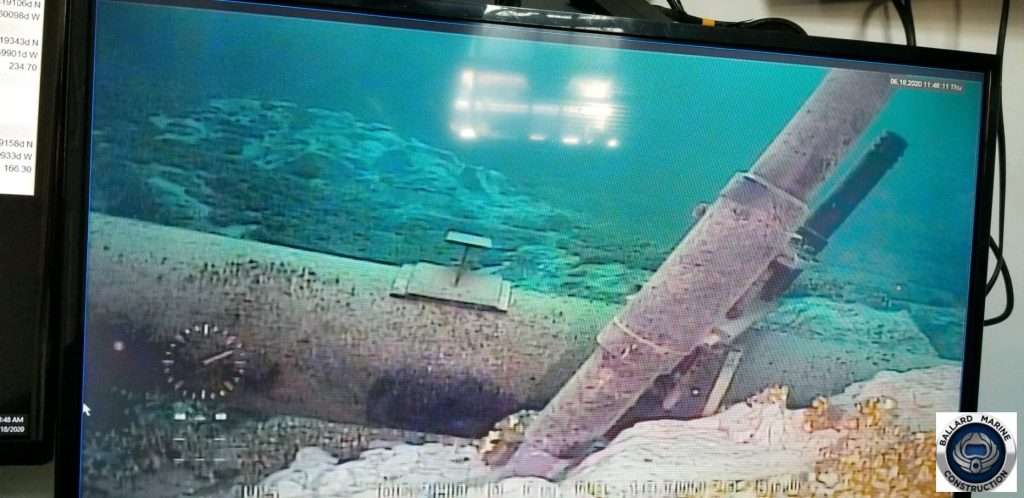
- Sections of pipeline are unsupported where they cross the lakebed.
- Protective coating has worn off, leaving bare metal exposed to freezing, churning currents.
- In 2018, a tugboat’s anchor struck and damaged the pipeline—highlighting how vulnerable it really is.
- In 2020, divers found the pipe suspended mid-water, bent and strained by erosion below.
This isn’t aging infrastructure. It’s collapsing infrastructure. And it’s buried beneath two of the most irreplaceable bodies of water on Earth.
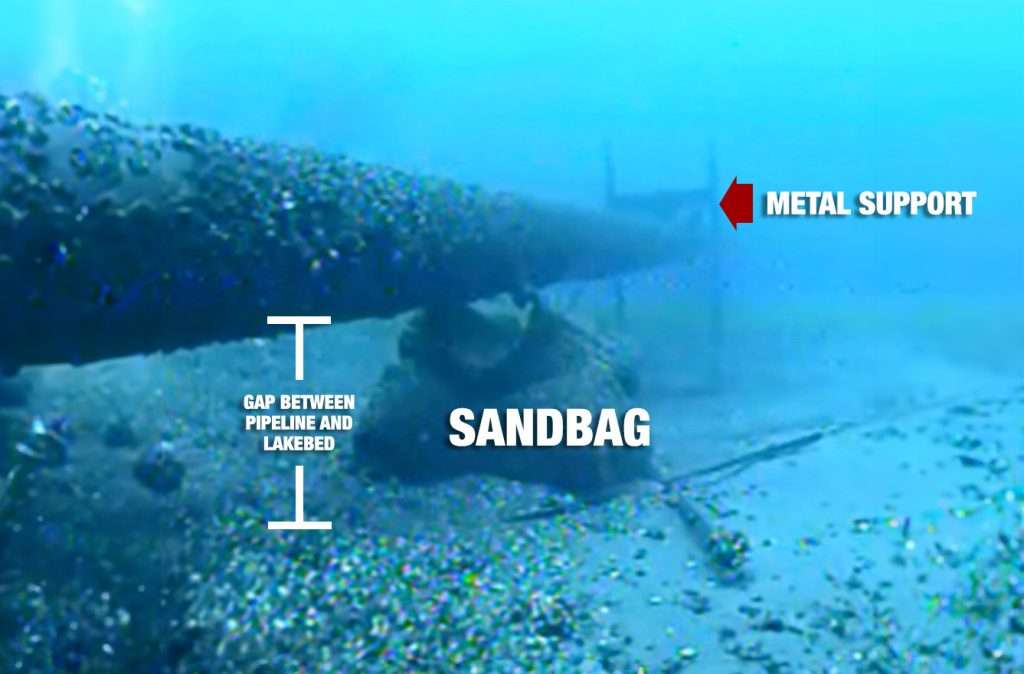
what the hell are we doing Michigan and canada?
Why are we letting a private oil company gamble with the Great Lakes—just to pump fuel through one of the most fragile freshwater crossings on Earth?
Most of what moves through Line 5 goes straight to Sarnia, Ontario. But if this pipeline fails, it’s not just Sarnia at risk, it’s everyone who depends on these waters.
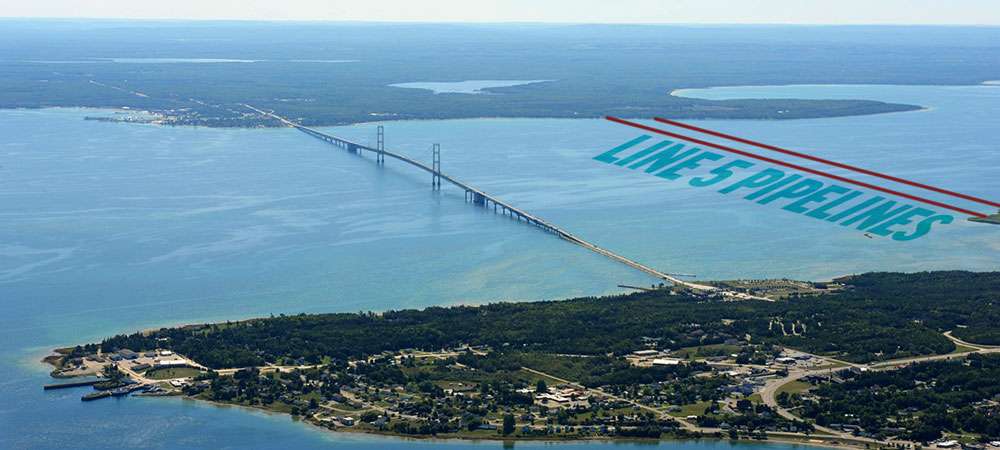
We don’t need this pipeline. And there are no viable arguments for keeping it that justify risking literally everything.
Line 5 is 71 years old. Unsupported. Corroded. Already struck by an anchor. We’re not waiting for a solution. We’re waiting for a catastrophe that we will never recover from.
If this pipeline ruptures, it’s not just Michigan and Ontario that suffer. It’s Wisconsin. Minnesota. Illinois. Indiana. Ohio. Pennsylvania. New York. The whole Great Lakes Basin pays the price. And possibly even beyond.
We MUST shut this down. Not later. Not after more studies.
Now!
Enbridge Doesn’t Live Here. We Do.
Enbridge—the Canadian multinational behind Line 5—is also responsible for the 2010 Kalamazoo River spill, which released more than 1 million gallons of tar sands oil into the river system. The rupture occurred on Line 6B (now Line 78) near Marshall, Michigan. Cleanup spanned four years and involved recovering 1.2 million gallons of oil and contaminated sediment. Over 35 miles of river were closed for more than a year. The final cleanup bill topped $1.21 billion. The National Transportation Safety Board called it “the costliest onshore spill cleanup in U.S. history.”
What was the penalty for Enbridge? A mere slap on the wrist. In July 2016, they agreed to a $177 million settlement with the U.S. Department of Justice and the EPA—$110 million for pipeline upgrades and safety improvements, $62 million in Clean Water Act penalties, and just $5.4 million to reimburse government cleanup costs. Insulting and obscene.
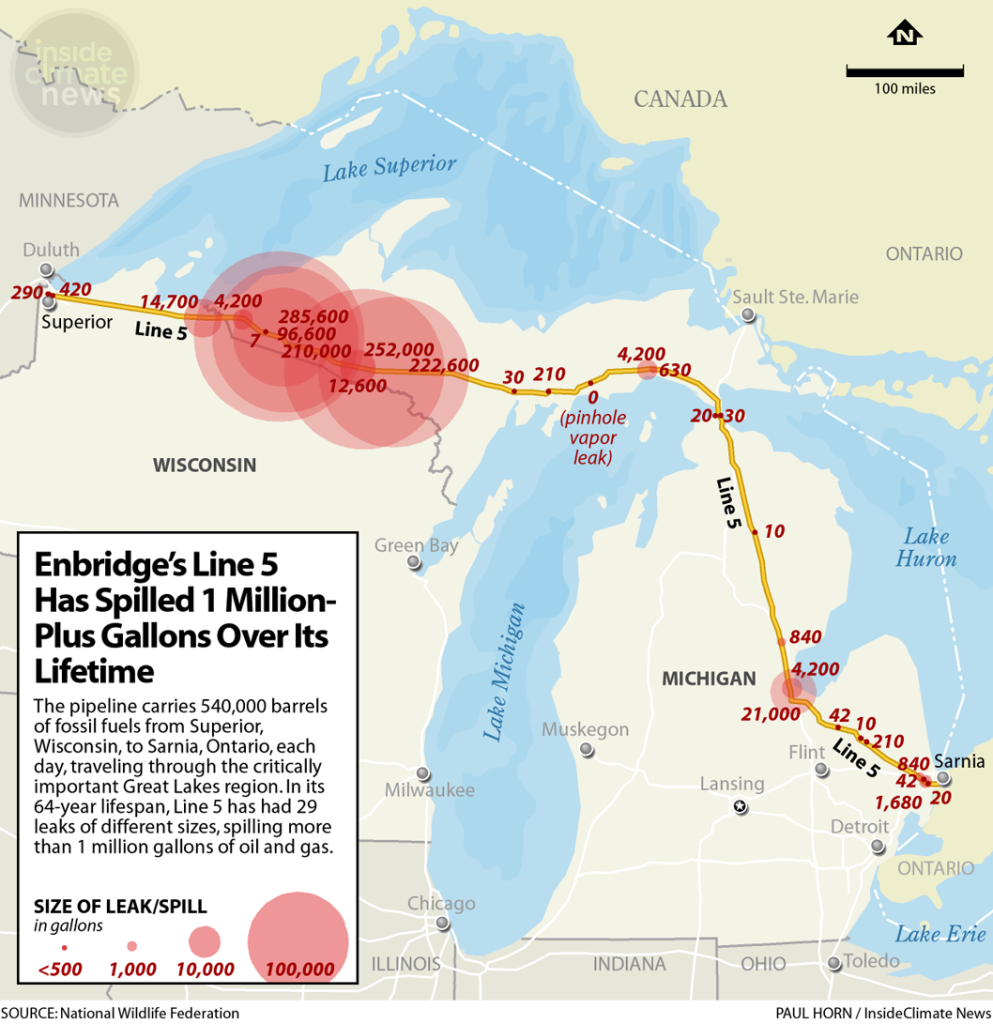
Beyond Kalamazoo, Enbridge has a long track record of disasters and spills throughout the Great Lakes Basin Region. Here are some of the most significant ones:
Grand Rapids, Minnesota. March 3, 1991: The Line 3 oil spill released ~1.7 million gallons of crude oil. At the time owned by Lakehead Pipeline Company (now Enbridge), the rupture occurred on a wetland near Grand Rapids spilling oil into the Prairie River, a tributary of the Mississippi River. It’s the largest inland oil spill in the history of the United States.
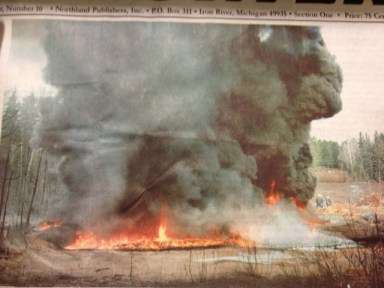
Crystal Falls, Michigan. November 1, 1999: released ~ 226,000 gallons (~5,300 barrels) of crude oil and natural gas liquids, triggering an evacuation of about 500 residents and a 36-hour fire to burn off leaked natural gas liquids (NGLs). Only ~115,000 gallons were recovered; cleanup involved removal of over 2,100 cubic yards of contaminated soil in the first two weeks. This remains the largest known spill of Line 5 and one of the most significant inland production-area incidents in the Great Lakes Basin Region.
Fort Atkinson Region, Wisconsin, April 26, 2019: Enbridge waited over one year to report the pipeline leak to the Wisconsin Department of Natural Resources. It wasn’t reported until July 31, 2020. The cause of the leak was identified as a faulty elbow joint. It left residents worried and wondering if their wells could be impacted by the spill.
Line 13, known as the Southern Lights Pipeline, runs from Manhattan, Illinois through Wisconsin and Minnesota, delivering products to Enbridge’s Edmonton terminal in Alberta, Canada. The company admitted that between 29-33 barrels of diluent had leaked into the ground on Blackhawk Island Road near Rock River and Lake Koshkonong. Juli Kellner, a communications staff member for Enbridge at the time, stated in an email to Milwaukee Journal Sentinel, “The safety of local residents and the environment is our main focus.” One would think if that is the case, they would have reported the leak immediately.
Jefferson County, Wisconsin. November 11, 2024: A reported carbon steel valve failure was the cause of a ~69,000 gallon (~1,650 barrels) leak of crude oil into the ground, 4 miles east of the village of Cambridge, Wisconsin. Cambridge is located between Milwaukee and Madison. According to federal data, the valve was originally installed in 1973 making it over five decades old.
Why We Must Shut Down Line 5 Now
These weren’t isolated incidents. They were warnings. And Enbridge still wants to double down. Today, Enbridge wants to build a $500 – $950 million tunnel under the Straits of Mackinac to replace the failing segment—but that tunnel would take 10 years to complete and doesn’t solve the immediate danger.
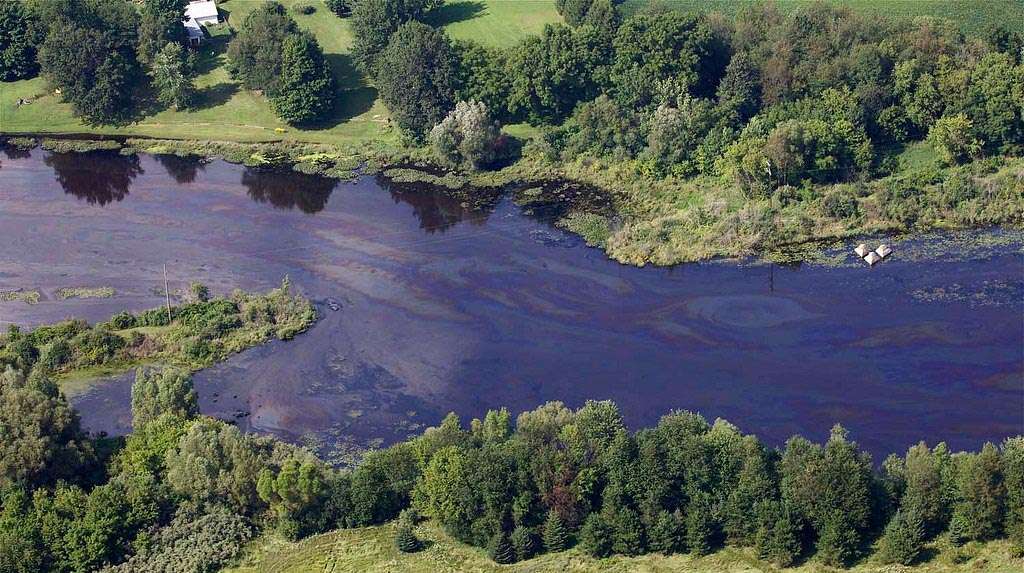
That’s 10 more years of risk. 10 more years of roulette.
Let’s be clear: this is not a solution. It’s a delay tactic. It’s a PR move designed to buy time and silence opposition while the oil keeps flowing. And every day it does, the risk of total ecological collapse gets worse.
We don’t need a tunnel. We need a shutdown. Permanent. Immediate. No debate.
Public Health vs Corporate Lies and Profits
Line 5 continues to operate not because it’s safe for the Great Lakes Basin Region, but because of legal doctrines like corporate personhood, which began with a manipulated court record in Santa Clara County v. Southern Pacific Railroad (1886) and was later weaponized by Citizens United v. FEC (2010) to give corporations expansive rights with almost no accountability.
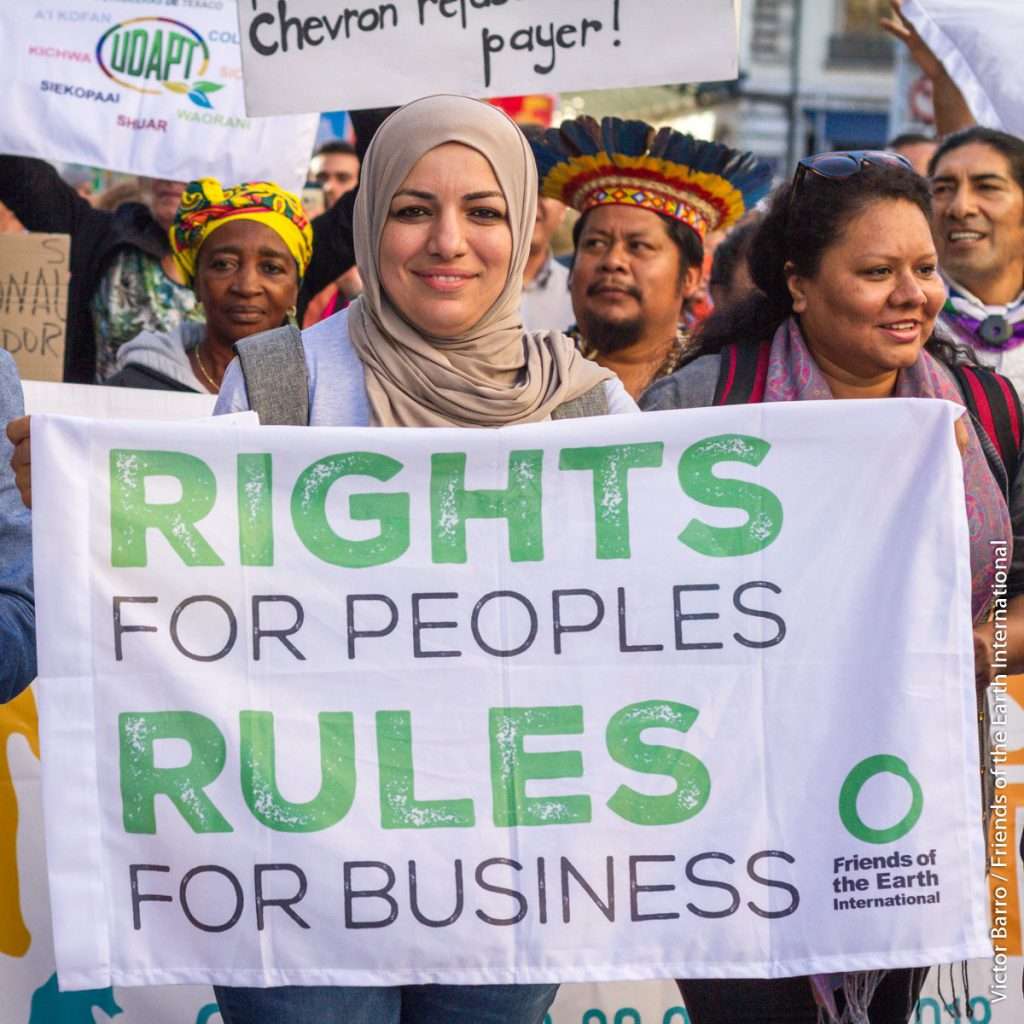
But corporations don’t drink this water. We do. And public health—access to safe, clean, uncontaminated water—is a human right. It cannot and must not be outweighed by profit.
We don’t want the pipeline. Fixing it isn’t the solution. Shutting it down is.
Public health usurps corporate “personhood”—a legal fiction born of a lie, manipulated to protect profits, not people.
Corporations do not have more rights than we do. They never did. That narrative was manufactured to serve extraction, exploitation, and environmental destruction. And we’re done pretending it’s legitimate.
Indigenous Nations Have Said No. It’s Time We Listened.
Multiple tribes, including the Bay Mills Indian Community, Little Traverse Bay Bands of Odawa Indians, and Bad River Band have called for Line 5’s shutdown, citing treaty violations and environmental destruction.

The Bad River Band won a federal case in 2023 ordering Enbridge to cease operation on tribal lands within three years—though the company continues to fight the ruling.
Bay Mills Tribal Chair Whitney Gravelle stated plainly: “the tunnel would destroy “not only the Great Lakes, but also an Indigenous people’s way of life, my way of life, for all Great Lakes Anishinaabe.”
The Canadian Government Invoked the 1977 Transit Pipelines Treaty
On November 13, 2020, Michigan Governor Gretchen Whitmer and the Michigan Department of Natural Resources (DNR) revoked the 1953 easement that allowed Enbridge to operate Line 5 in the Straits of Mackinac. The revocation cited Enbridge’s “persistent and incurable violations” of the easement conditions. Particularly regarding environmental risk, safety, and structural integrity. The order gave Enbridge 180 days to shut down Line 5, no later than May 12, 2021.
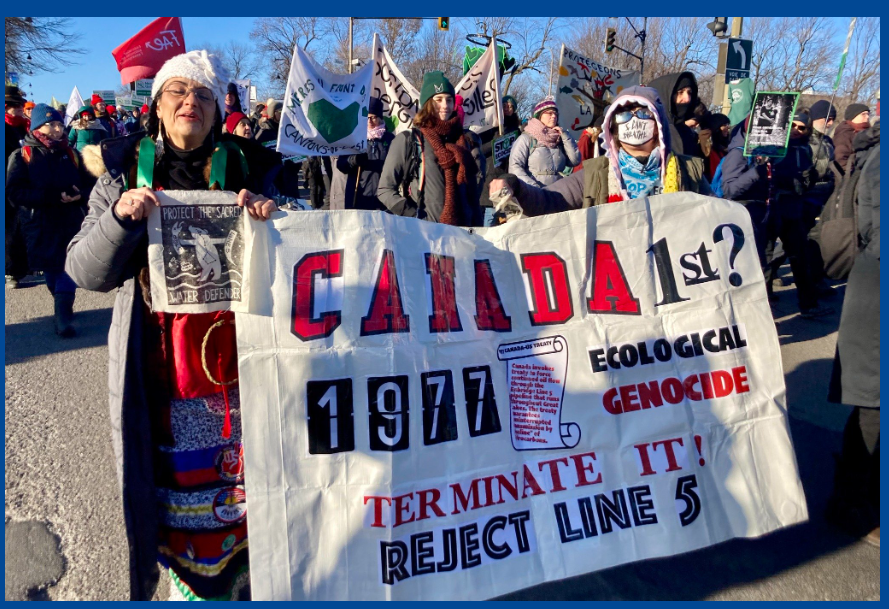
In response, Canada invoked the 1977 Transit Pieplines Treaty to block Michigan’s shutdown order and challenged it in federal court—not to protect public health, but to protect a handful of oil-sector jobs and profits. Enbridge argued that only the federal government has jurisdiction over interstate pipelines.
This treaty was never meant to override environmental risk or Indigenous rights. It’s now being used to delay action while the pipeline continues to operate, age, and erode at grave risk to the Great Lakes Basin Region. This isn’t diplomacy. It’s blackmail by fossil fuel lobbyists.
What We’re Risking
- 40 million people’s drinking water
- Tribal treaty rights and sacred ecosystems
- Entire freshwater-dependent regional economies
- Collapse of species that rely on cold, clean water
- A climate future made worse by continued fossil fuel dependency
But What About the Alternatives?
Enbridge and its defenders love to pretend there’s no way to live without Line 5. That it’s either “keep it running” or lose propane, fuel, jobs, heat. That’s a lie. Enbridge itself has stated that Line 5 supports only about 100 permanent jobs in Michigan. Most of the pipeline labor is tied to construction and maintenance and not long-term operations. Jobs can be shifted and the Lakes can be spared.
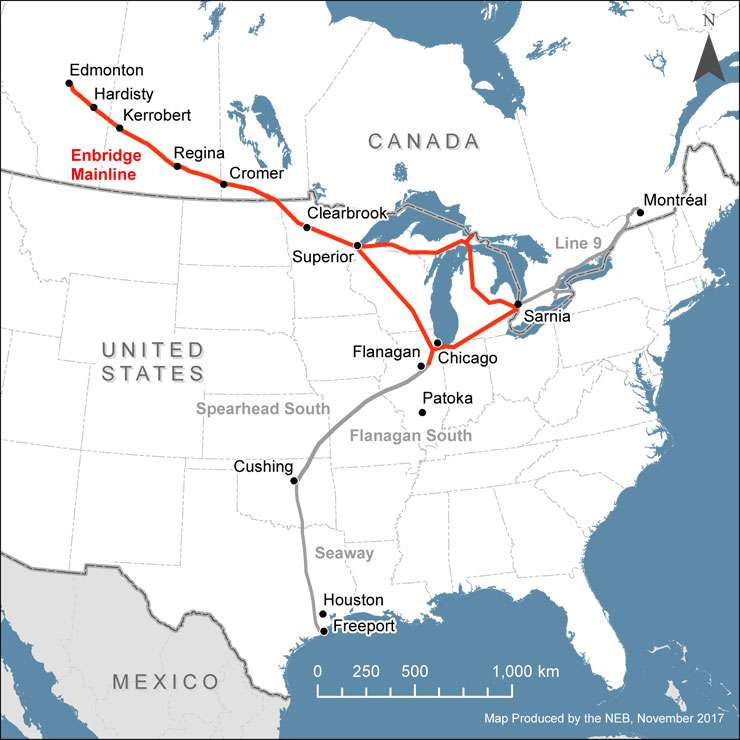
There are real, proven alternatives—and they don’t require running oil through the most fragile point in the Great Lakes Basin. You can acces both the Michigan Line 5 Alternative Study and the Michigan Refining Sector: Alternatives to Enbridge Line 5 For Transportation Study.
1. Use existing pipelines that don’t threaten water
Enbridge Line 78 (formerly Line 6B) already runs from Indiana to Sarnia, Ontario—the same destination as Line 5. It has excess capacity and was upgraded after the Kalamazoo disaster. Ramping up capacity here would require new pumping stations, safety inspections, monitoring crews—all of which will shift jobs away from Line 5 and to Line 78.
2. Move product by rail or truck—especially for propane.
Oil and propane already move across North America this way. For regional use—especially in Michigan’s U.P.—this is a viable short-term solution while building toward permanent transition.
3. The Upper Peninsula doesn’t need Line 5.
Michigan’s Public Service Commission confirmed that U.P. propane needs can be met without Line 5. With expanded truck delivery, storage hubs, and rail infrastructure, nobody needs to go cold and jobs can shift to meet these needs.
4. Most of Line 5’s product is for Canada—not us.
Line 5 is a foreign export route. Most of the crude it carries goes straight to Ontario refineries, not Michigan homes, and we’re taking the risk for someone else’s profit.
5. We can transition away from it—if we choose to.
Renewables, heat pumps, weatherization, and regional energy independence are already in motion across the Midwest. Line 5 isn’t about what we need. It’s about what Enbridge refuses to give up. The proposed $500-$950 million in tunnel money could fund these initiatives.
When it comes to Canadian jobs, the majority of Line 5 jobs are refinery-dependent, not pipeline-specific. The “job losses” are nothing but a scare tactic that the fossil fuel industry always falls back to. As outlined, jobs can be shifted to existing and safer, future-facing infrastructure.
So next time someone asks, “But how else would we get propane?”—show them this. The solutions are already here. We’re just not being told the truth.
There Is Only One Answer: Shut down Line 5!
No reroute.
No tunnel.
No more lies.
Because public health is not negotiable.
Because treaty rights are not optional.
Because “corporate personhood” was born of fraud and used to strip us of our power.
Shut down Line 5 before it shuts us down.
Watch the documentary “Great Lakes, Bad Lines” by Patagonia below and SHARE IT! Other ways to get involved are listed below.
Viable Actions to Take Right Now
1. Demand State-Level Enforcement of the Easement Revocation
Michigan revoked Enbridge’s Line 5 easement in 2020, but Enbridge is ignoring the order while it fights in court.
What to do:
- Contact Michigan’s Attorney General and Governor to demand full enforcement of the easement revocation.
- Sign petitions and amplify calls for shutdown led by Oil & Water Don’t Mix.
2. Support Tribal Sovereignty and Legal Actions
Tribes like the Bay Mills Indian Community and Bad River Band have taken legal action to stop Line 5.
What to do:
- Publicly support tribal lawsuits and share their legal victories
- Write letters to editors and post on social media using tribal statements (e.g., Whitney Gravelle: “We will not allow this pipeline to threaten our land, our water, or our way of life.”)
- Donate to or partner with tribal-led environmental efforts
3. Pressure Canadian and U.S. Officials to Withdraw Treaty Shielding Line 5
Canada invoked a 1977 pipeline treaty to block Line 5 shutdown. This diplomatic shield must be challenged.
What to do:
- Urge elected officials (especially in New York, Michigan, and Ontario) to call for renegotiation or withdrawal from the treaty.
- Contact Canadian MPs and U.S. Senators, especially those on environmental and international committees.
4. Local Government Resolutions
Cities and counties across the Great Lakes have already passed resolutions calling for a Line 5 shutdown.
What to do:
- Organize a local campaign to pass a city council or county board resolution opposing Line 5.
- Use Oil & Water Don’t Mix’s resolution toolkit as a guide.
5. Get Involved in Public Comment Periods and Permitting Hearings
The Army Corps of Engineers is still reviewing permits for the proposed tunnel. Public pressure matters.
What to do:
- Submit comments during the federal permitting process (watch for updates here).
- Attend public hearings (virtual and in-person) and submit testimony.
6. Boycott and Divest from Banks Funding Enbridge
Major banks fund pipeline construction. Financial pressure works.
What to do:
- Move personal or organizational funds from banks funding Enbridge (Chase, TD Bank, RBC, etc.)
- Join or promote campaigns like Stop the Money Pipeline.
7. Educate, Organize, and Mobilize
Most people don’t even know Line 5 exists—or that it crosses the Great Lakes lakebed.
What to do:
- Host community events, teach-ins, screenings (e.g., “Great Lakes, Bad Lines” documentary by Patagonia).
- Start a campaign or coalition in your community focused on shutting down Line 5.
- Write articles, create TikToks, or share images and maps showing the risk.








